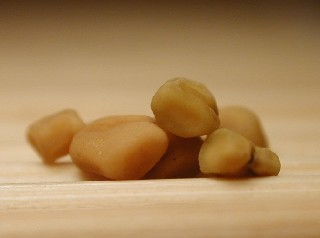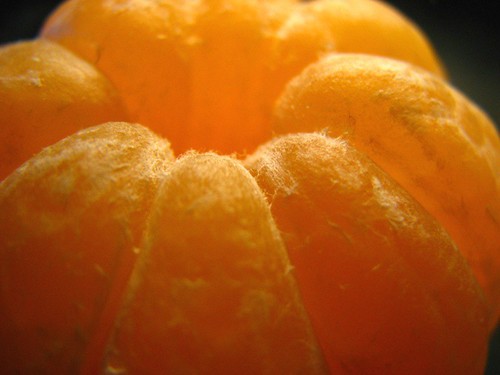Osmanthus Marathon
Osmanthus Whispers
I find it quite difficult, generally speaking, to document my progress during the process of designing a fragrance (except for, obvioiusly, documenting the actual formulas, for technical reasons). I usually start with a concept – an inspiration. I obsess about it for a while (anywhere between a day and a few years) before I start to actually, physically, blend and marry the essences I have chosen. There process is rather internal for the most part, but can be also viewed on my endless notebooks, sticky notes, index cards, napkins, anything that one can write on (that is only if I don’t have my note book with me – which is very rare: I carry a note book everywhere I go, just like a photographer must carry a camera, I need a tool to capture my olfactory visions whenever they occur). My formulas are written in a secret arcane language of mythical alchemical hieroglyphs, so that only few can understand. When I go to my pyramid, I will take them with me and everybody will have to try and decipher my formulas from scratch (with a little help from a mystical chromatograph).
This kind of documentation is part of the process. But it’s difficult for me to go beyond that. I find it distracting. Rather, I prefer to share whatever internal process it is that I go through in the more abstract way, that brought me to experiment with one material or the other. I spend more time conceiving perfumes than blending them, and so I find that usually, the technical part, of actually blending the essences into alcohol in certain quantities is just the very end of a long mental process. Just like a baby’s head popping out of a mother does not reveal much about the conception and the long months spent in the womb. I can’t imagine myself documenting myself when in labour – anyways, not on my blog…
Another thing there is to say – I am trying not to create new scents. My line has many already. I should try sell more of them first. It is really hard to step back, and I am trying hard… Most of my perfumes were created before I even knew how to blog, and when I had no intention of keeping a diary. So any documentation is going to be in retrospect. And I do intend to tell the stories of each of my scents one day, despite the fact that I feel they already do tell a story. My perfumes are created in an overwhelming abundance and spontaneity. To document that would be quite overwhelming, but I am looking forward to that. Most of them have a strong connection to a person or a memory. Others were inspired by the essences themselves, and when I smell them a few months later – I realize they have created a memory already. I feel really lucky to be able to
I have decided, though, because I have shared with you some of my soliflore thoughts, and I am in the midst of creating a new soliflore (which I probably shouldn’t!) - to try something new. So I will share with you the evolution of my osmanthus soliflore, which I haven’t yet decided how to call it (which is one part of the problem). It’s an interesting experiment for me, in seeing how recording the physical phases helps me out with achieving my goals for the perfume. But also it’s an interesting spin on the observer’s effect. Will sharing my process interfere with the result? We will see.
July 6th 2006 Osmanthus Phase One
This is my first try. I went bold and daring, and put in the greediest ingredients I had in terms of olfactory space. Including two that I am not at all familiar with, and that are not particularly accommodating. I hoped that helicrysum absolute (a material I am using for the first time) will provide a dark, tea-like base, and that davana will add fruitiness. Well, I was not far off. At first it seemed to go rather well and smell osmanthusy and full bodied. However, after a very short period of time, the osmanthus and fruit wears off, and a pungent, persistent body odour creeps at me. As if I was taking my food with Hilbah - a Yemenite fenugreek condiment (this can happen also after eating certain East Indian curries, also made sometimes with fenugreek). For the same reason I avoid Hilbah in all its forms, I am tempted to avoid this phase one. It’s dark alright! But not what I want. The davana adds a somewhat repelling winey note, but if you bear with it for a while you got to like it for what it has to offer. It does steal the show now, though, after maturing for about a week. It will be interesting to see what it turns into in a few more days. Nice try though.
July 7th 2006, Osmanthus Phase Two
No helicrysum in this cup of tea. I will need to find another use for this note, and I am sure I will. Helicrysum essential oil, by the way, is a completely different story: it’s like an eternal sun of honey. This time I kept the base rather light, staying cautious to not overpower the osmanthus. The top was lightened with Clementine CO2. The result is fruity and bright, but not very long lasting. Although the Clementine and citrus notes complement the osmanthus, the result is sunny. I wanted a dark osmantus. The base is yet to reveal how substantial it is. But I am not happy with the lasting power, not at this concentration, anyways.
July 12th 2006, Osmanthus Phase Three
More osmanthus absolute this time, to assert the osmanthisism of the composition. I decided to be a bit daring again, but this time go with a material I am more familiar with: tabac blond. It has an earthy, dry leaf quality that is not unlike tea. It creates an illusion of black tea. I also doubled up the other base notes (used in the previous versions) – ambrette, sandalwood, green tea. The heart remains basically the same, focusing on osmanthus, with a couple of supporting notes that share some similarities: a tad of lavender Seville absolute and linden blossom absolute. This time I used only the ethereal wild orange top note, and omitted the clementine. It is just fruity enough to help the osmanthus out, but not too sweet to distract from the darkness of the osmanthus. It really showcases the phases of osmanthus – from peach/apricot, to leather and finally to a smooth green tea. The only thing I am not happy with yet is the lasting power, and so I will increase the concentration and see how it improves the perfume.
- Previous
- Page 6 of 6
- Next
- Previous
- Page 6 of 6
- Next




